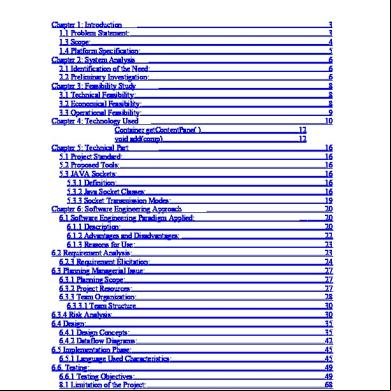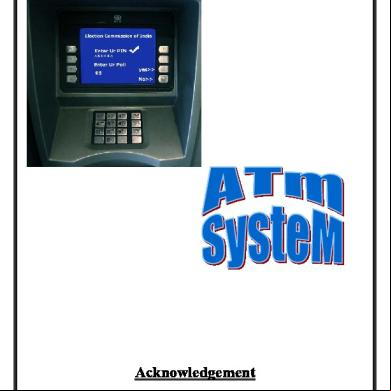Atm Project Report 306t1d
This document was ed by and they confirmed that they have the permission to share it. If you are author or own the copyright of this book, please report to us by using this report form. Report 2z6p3t
Overview 5o1f4z
& View Atm Project Report as PDF for free.
More details 6z3438
- Words: 820
- Pages: 16
1.PROJECT ABSTRACT
1
1. PROJECT ABSTRACT 1.1. INTRODUCTION: The project “ATM TRANSACTION” is implemented in Visual Basic 6.0. It is used by all banks in their ATM machine (Automatic Teller Machine).In earlier years all the transactions were to be done manually, still done but very rarely, as it is a difficult task. So now banks use this to give their customers to have easy & faster transactions. Thus our this project is a good task to have transactions easier, faster & for emergencies.
1.2. SCOPE:
It can be implemented in ATM machine by owner of bank or in charge of branch It is easy to learn the task
1.3. OBJECTIVES: Our main objective is to speed up the transactions done by customers. No manual transactions needed generally. The second objective is to save the time which is very important now-a-days.
2
2.TOOLS / PLATFORM / LANGUAGES
3
2. TOOLS / PLATFORM / LANGUAGES 2.1. TOOLS:
Processor Hard Disk RAM Printer Monitor Pointing Device
:- Intel Pentium 4 or Later or Compatible :- 10GB or more :- 256MB or more :- Any :- SVGA Color Monitor (Touch Screen or Simple) :- Touch Pad or Keys
2.2. PLATFORM: Operating System :- Microsoft Windows XP or Later or Equivalent
2.3. LANGUAGES: Front End Back End
:- Visual Basic 6.0 :- Oracle 8i
4
3.PROJECT PLANNING / SCHEDULING
5
3. PROJECT PLANNING / SCHEDULING
20
Create Toll in VB
18
Recheck Availability
16
State Chart & Activity Diagram Seq & Coll Diagram
14 12
Use Case & Activity Diagram
10
Design Database
8
Project Design
6 4 2
Project Abstract Project Planning
0 lab1
lab2
lab3
lab4
lab5
lab6
lab7
lab8
lab9
6
4.SYSTEM ANALYSIS
7
4. SYSTEM ANALYSIS 4.1. STUDY OF CURRENT / EXISTING SYSTEM:
In the manual system, firstly the bank manager and its staff have to manage information regarding the s and transaction of all the customers manually. Doing this manual transaction was really tedious job. Secondly information regarding s and transactions of customers were to be maintained. This process is time consuming and it requires a great manual effort.
Disadvantages:
More time is consumed. More hard work to maintain all records. Bulk of paper is to be searched for a single search.
4.2. FEASIBILITY STUDY:
4.2.1.TECHNICAL FEASIBILITY: The system is being developed in Visual Basic 6.0. It provides comprehensive function to make it friendly. The data entry and report generation is also made easy. Backup and restore of the database facility are also provided. It also provides easy retrieval of data. The machine configuration also s this software.
4.2.2. SOCIAL FEASIBILITY: As this system is friendly and flexible some problems will also be solved which employee may be facing when using existing system. So we can say that system is socially feasible.
8
4.2.3. ECONOMICAL FEASIBILITY: The cost of converting from manual system to new automatic computerized system is not probably more. For construction of the new system, the rooms and its facilities are available so it does not require any extra resource, only the software requirement is there.
4.2.4. OPERATION FEASIBILITY: Since the system is being in friendly way, the new customers within a few time can master it.
4.3. DESIGN OF NEW PROPOSED SYSTEM (UML): This system provides paperless maintenance. Initially a cashier or an clerk can be appointed to do all the transaction and update and maintain records. In the new system the customer himself can do all the transaction and the computerized system automatically updates and maintains the records.
Advantages:
Less effort to complete transaction. Less time required. No need to maintain the bulk of papers.
9
5.SYSTEM DESIGN
10
5. SYSTEM DESIGN 5.1. DATA DICTONARY: Table Name: customer
Column Name cust_id cust_name Dob _no cust_add a_c_no a_c_type Bal card_no card_pin b_branch_id
Data Type varchar2 varchar2 date number varchar2 varchar2 varchar2 number number number varchar2
Table Name: bank
Column Name b_branch_id b_branch_name b_branch_add b__id
Data Type varchar2 varchar2 varchar2 varchar2
Table Name: b_
Column Name b__id b__name b__pin b__rights
Data Type varchar2 varchar2 number varchar2
11
Table Name: atm
Column Name a_branch_id a_branch_name a_branch_add a__id available_cash b_branch_id
Data Type varchar2 varchar2 varchar2 varchar2 number varchar2
Table Name: a_atm
Column Name a__id a__name a__pin a__rights a_branch_id
Data Type varchar2 varchar2 number varchar2 varchar2
5.2. DIAGRAM DESIGN (UML): 5.2.1.USE CASE DIAGRAM:
ATM
Customer
<<extend>>
atm
customer
balance card_no branch_name
branch_id
available_cash
pin_no cust_name
saving
type of a/c
current
12
5.2.2.ACTIVITY DIAGRAM:
13
5.2.3.SEQUENCE DIAGRAM:
atm
bank
1: card 2: req pin
3: enter pin 4: proccesing
5: 6: valid
7: option
8: transaction 9: transaction complete 10: collect reciept
14
5.2.4.COLLABORATION DIAGRAM: 1: card 3: enter pin 8: transaction
atm 2: req pin 4: proccesing 7: option 9: transaction complete 10: collect reciept 6: valid
5:
bank
5.2.5.CLASS DIAGRAM:
15
5.2.6.STATE CHART DIAGRAM:
16
1
1. PROJECT ABSTRACT 1.1. INTRODUCTION: The project “ATM TRANSACTION” is implemented in Visual Basic 6.0. It is used by all banks in their ATM machine (Automatic Teller Machine).In earlier years all the transactions were to be done manually, still done but very rarely, as it is a difficult task. So now banks use this to give their customers to have easy & faster transactions. Thus our this project is a good task to have transactions easier, faster & for emergencies.
1.2. SCOPE:
It can be implemented in ATM machine by owner of bank or in charge of branch It is easy to learn the task
1.3. OBJECTIVES: Our main objective is to speed up the transactions done by customers. No manual transactions needed generally. The second objective is to save the time which is very important now-a-days.
2
2.TOOLS / PLATFORM / LANGUAGES
3
2. TOOLS / PLATFORM / LANGUAGES 2.1. TOOLS:
Processor Hard Disk RAM Printer Monitor Pointing Device
:- Intel Pentium 4 or Later or Compatible :- 10GB or more :- 256MB or more :- Any :- SVGA Color Monitor (Touch Screen or Simple) :- Touch Pad or Keys
2.2. PLATFORM: Operating System :- Microsoft Windows XP or Later or Equivalent
2.3. LANGUAGES: Front End Back End
:- Visual Basic 6.0 :- Oracle 8i
4
3.PROJECT PLANNING / SCHEDULING
5
3. PROJECT PLANNING / SCHEDULING
20
Create Toll in VB
18
Recheck Availability
16
State Chart & Activity Diagram Seq & Coll Diagram
14 12
Use Case & Activity Diagram
10
Design Database
8
Project Design
6 4 2
Project Abstract Project Planning
0 lab1
lab2
lab3
lab4
lab5
lab6
lab7
lab8
lab9
6
4.SYSTEM ANALYSIS
7
4. SYSTEM ANALYSIS 4.1. STUDY OF CURRENT / EXISTING SYSTEM:
In the manual system, firstly the bank manager and its staff have to manage information regarding the s and transaction of all the customers manually. Doing this manual transaction was really tedious job. Secondly information regarding s and transactions of customers were to be maintained. This process is time consuming and it requires a great manual effort.
Disadvantages:
More time is consumed. More hard work to maintain all records. Bulk of paper is to be searched for a single search.
4.2. FEASIBILITY STUDY:
4.2.1.TECHNICAL FEASIBILITY: The system is being developed in Visual Basic 6.0. It provides comprehensive function to make it friendly. The data entry and report generation is also made easy. Backup and restore of the database facility are also provided. It also provides easy retrieval of data. The machine configuration also s this software.
4.2.2. SOCIAL FEASIBILITY: As this system is friendly and flexible some problems will also be solved which employee may be facing when using existing system. So we can say that system is socially feasible.
8
4.2.3. ECONOMICAL FEASIBILITY: The cost of converting from manual system to new automatic computerized system is not probably more. For construction of the new system, the rooms and its facilities are available so it does not require any extra resource, only the software requirement is there.
4.2.4. OPERATION FEASIBILITY: Since the system is being in friendly way, the new customers within a few time can master it.
4.3. DESIGN OF NEW PROPOSED SYSTEM (UML): This system provides paperless maintenance. Initially a cashier or an clerk can be appointed to do all the transaction and update and maintain records. In the new system the customer himself can do all the transaction and the computerized system automatically updates and maintains the records.
Advantages:
Less effort to complete transaction. Less time required. No need to maintain the bulk of papers.
9
5.SYSTEM DESIGN
10
5. SYSTEM DESIGN 5.1. DATA DICTONARY: Table Name: customer
Column Name cust_id cust_name Dob _no cust_add a_c_no a_c_type Bal card_no card_pin b_branch_id
Data Type varchar2 varchar2 date number varchar2 varchar2 varchar2 number number number varchar2
Table Name: bank
Column Name b_branch_id b_branch_name b_branch_add b__id
Data Type varchar2 varchar2 varchar2 varchar2
Table Name: b_
Column Name b__id b__name b__pin b__rights
Data Type varchar2 varchar2 number varchar2
11
Table Name: atm
Column Name a_branch_id a_branch_name a_branch_add a__id available_cash b_branch_id
Data Type varchar2 varchar2 varchar2 varchar2 number varchar2
Table Name: a_atm
Column Name a__id a__name a__pin a__rights a_branch_id
Data Type varchar2 varchar2 number varchar2 varchar2
5.2. DIAGRAM DESIGN (UML): 5.2.1.USE CASE DIAGRAM:
ATM
Customer
<<extend>>
atm
customer
balance card_no branch_name
branch_id
available_cash
pin_no cust_name
saving
type of a/c
current
12
5.2.2.ACTIVITY DIAGRAM:
13
5.2.3.SEQUENCE DIAGRAM:
atm
bank
1: card 2: req pin
3: enter pin 4: proccesing
5: 6: valid
7: option
8: transaction 9: transaction complete 10: collect reciept
14
5.2.4.COLLABORATION DIAGRAM: 1: card 3: enter pin 8: transaction
atm 2: req pin 4: proccesing 7: option 9: transaction complete 10: collect reciept 6: valid
5:
bank
5.2.5.CLASS DIAGRAM:
15
5.2.6.STATE CHART DIAGRAM:
16










